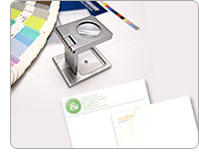- Products
-
Design Templates
- Featured Design Galleries
- More Galleries
- Services & Resources
- Free Sample Kit
- Deals
Like all print marketing, your letterhead will look just as hot off the press as it does on your computer screen when you understand the letterhead printing process, how it affects the finished product and what you can do to ensure your letterhead is amazing. The following letterhead printing techniques relate the expertise you need to get the job done right the first time:

Your letterhead should be designed using four-color process (CMYK) and in a resolution of at least 300 dpi for optimal results. Before you even begin designing your letterhead, you should get a free professional letterhead template, which contains guides so you can make sure your letterhead bleeds extend all the way to the edge of the paper and your important letterhead elements are all within the safety area.
Letterhead paper is of higher quality than ordinary printer paper, and for good reason. Customers and business partners equate the feel of your letterhead paper with the feel of your company. Too flimsy, you come off as sloppy; too thick, and you appear rigid. Go with a letterhead paper that offers the perfect balance between stability, smoothness and sheen for a clean, professional look that feels great in the hands of your prospects. Premium 24-pound synergy bond paper is an excellent choice for letterhead paper.
Your letterhead should be rounded out by matching envelopes and second sheets. Your envelopes should match your letterhead size and paper. If you choose premium paper for your letterhead, you should also choose premium paper for your envelopes (and second sheets).
When it comes to printing letterhead, the more your print, the cheaper it gets. So much of your cost is in setting up the offset press, so printing more letterhead per run means your cost per piece is significantly reduced (the same applies to envelopes). Order enough letterhead for the next year or two to ensure you don't run out when you need it and to maximize your overall branding and marketing return on investment.
 It's always a good idea to get a hardcopy proof of your letterhead and envelopes before you run the entire job. This way you can make last-second changes if you catch mistakes in text or design, which can sometimes be difficult to pick up on a computer screen. Second sheets are typically blank, so will not require a proof; however, if you want to know what the paper will feel like in your customers' hands, you should request a sample. Letterhead printing is an easy process when you understand how your identity comes together on a printing press. Follow these printing techniques to ensure your next full color letterhead printing project goes off without a hitch.
It's always a good idea to get a hardcopy proof of your letterhead and envelopes before you run the entire job. This way you can make last-second changes if you catch mistakes in text or design, which can sometimes be difficult to pick up on a computer screen. Second sheets are typically blank, so will not require a proof; however, if you want to know what the paper will feel like in your customers' hands, you should request a sample. Letterhead printing is an easy process when you understand how your identity comes together on a printing press. Follow these printing techniques to ensure your next full color letterhead printing project goes off without a hitch.